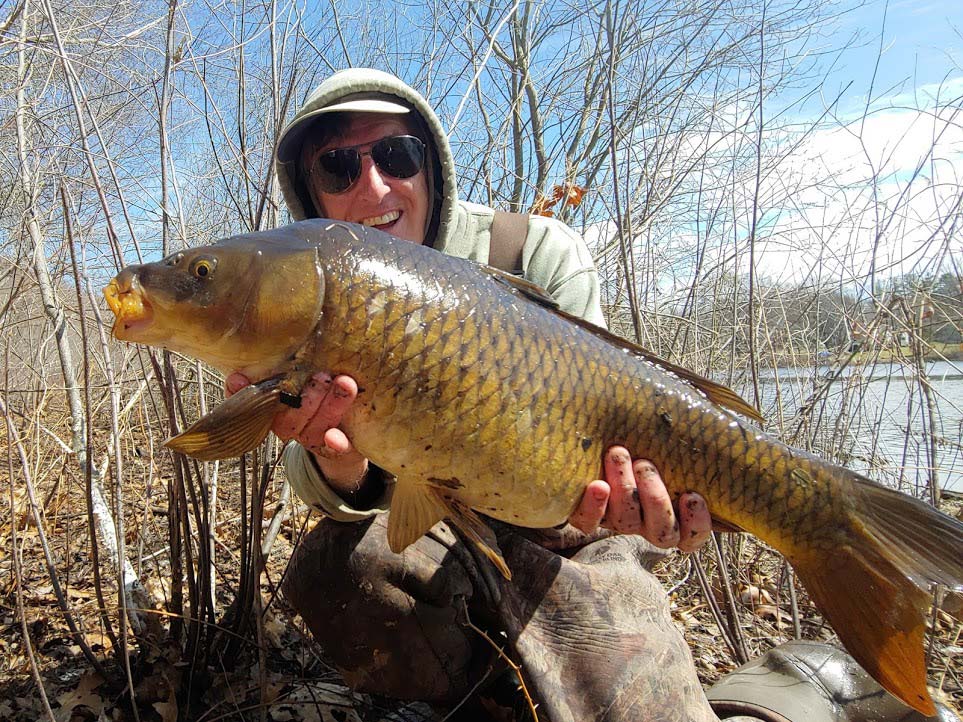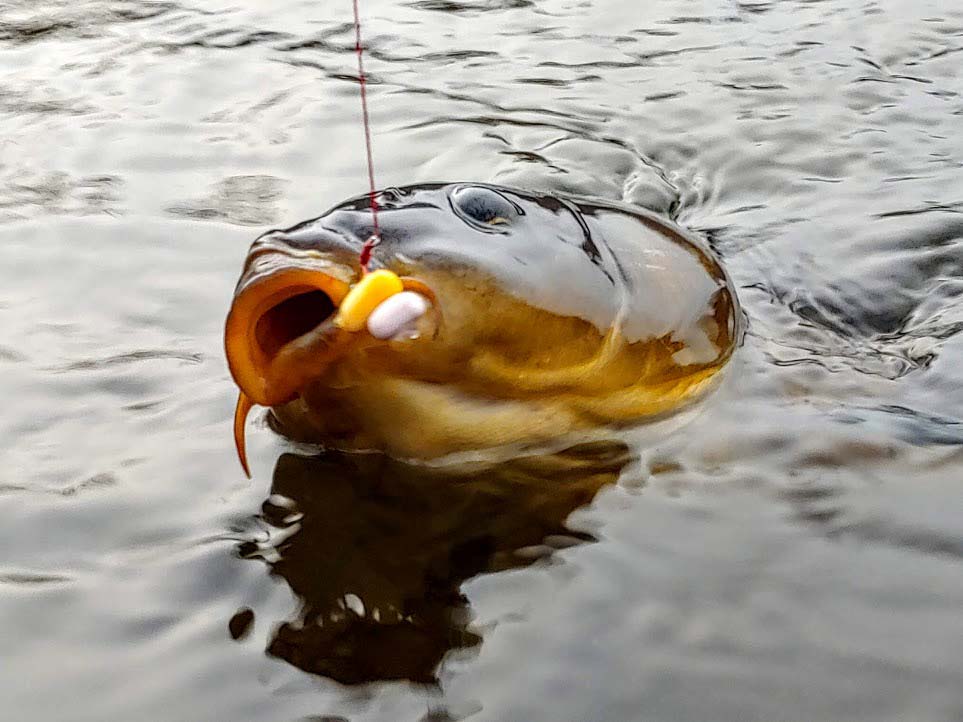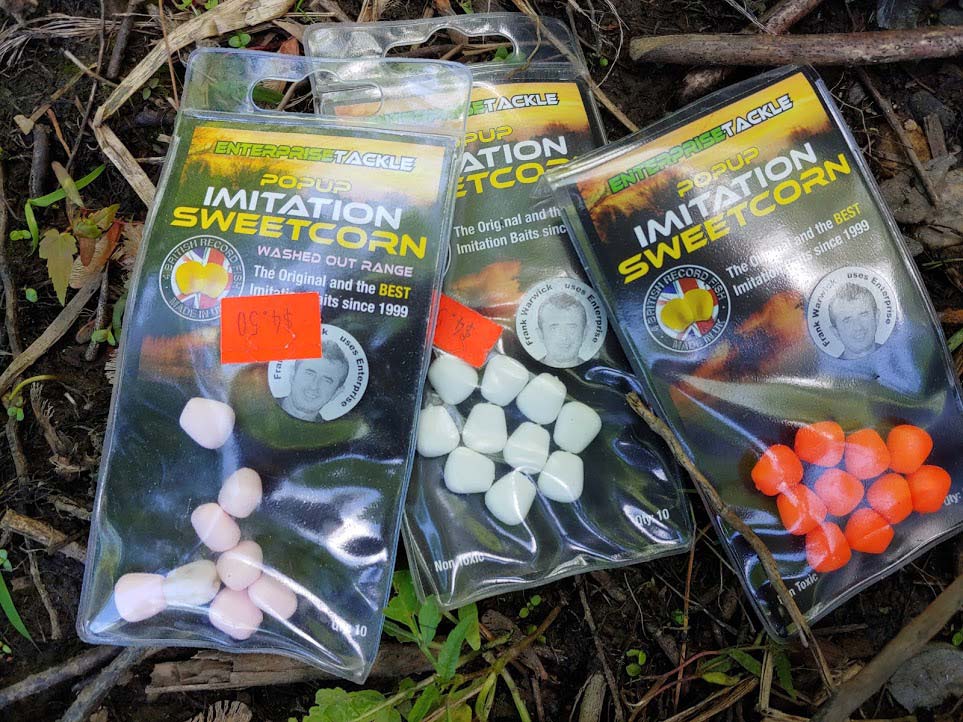
While you wait for stripers to arrive and trout season to open, why not kick off your season by tangling with a giant ‘goldfish’?
Carp fishing begins in southern New England as soon as the ice departs. Based on recent years, that should happen in the beginning of March. These jumbos of freshwater will quickly go from a semi-dormant life under the ice to actively moving around and feeding, presenting an opportunity for anglers eager to bend a rod with a tackle-testing adversary seldom rivaled in local waters.
When targeting these early carp, location is a key component in finding not just consistent success, but success in general. The very best places to target early season carp would be small ponds that heat up quickly in a March sun. Look for lakes and ponds smaller than 5 acres in size and generally under six feet in depth with the smaller and shallower the better. The best early season carp ponds have dark-colored bottoms that absorb the sun’s rays days causing the carp’s activity levels to perk up and feeding to accelerate.
One of the major issues with finding these ideal places to fish is that not all ponds have carp since they are not native to southern New England. That said, I have discovered a lot of good small spots simply by fishing and looking for telltale signs including jumping fish, mud trails, suggestions from fellow fishermen and even by seeing carp sunning themselves in the shallows.
Another way I find potential carp ponds is with Google Earth. Here’s a big hint: nearly all of our rivers in southern New England hold carp. If you can find where a small river widens to form a pond, this area is likely to hold spring carp. I also look for places where small ponds are connected to bigger rivers. For example, I have located many spots on the Blackstone River, which runs through both Massachusetts and Rhode Island, in this very manner.
I also find small carp ponds that come off bigger bodies of water. If you can find ponds that branch off a big lake, those spots can be extremely productive. Carp move in from those bigger and deeper bodies of water to the smaller adjoining “ponds” in search of warm spring water and food in March.

Last year my best March outing occurred on March 6 when I fished a small venue in Massachusetts. The ice had completely departed a few days earlier and the carp were on the feed. That day I landed 12 carp, a solid score for the early going. These fish ranged from 5 to 10 pounds, typical size for the early hitters and far larger than almost any other available species in this timeframe. All the fish fell for a combo bait of sweet corn and an artificial corn fished on a hair rig (more on that later.) I have also landed some big fish in the early going so don’t be surprised if you find yourself fighting fish in the high teens or even the 20-pound class in March.
Rules and regulations vary from state to state pertaining to both the carp themselves as well as the waters in which you may target them. In Rhode Island, for example, you can target any species of fish any time of the year in non-stocked trout waters. However, trout-stocked waters that also hold carp are off limits in March until Opening Day (April 10, 2021 this year), regardless of your target species. In Massachusetts, with no closed season on trout, you are good to go in all waters right now (unless they have specific unique rules.) In Connecticut, similar to Rhode Island, trout-stocked waters are also off limits from the final day of February through Opening Day (April 10, 2021 this year.) Keep in mind that you will also require a freshwater/inland fishing license for each state in which you plan to fish as there is no reciprocity for freshwater fishing licenses like that of the salt.
Early spring carp fishing is less complicated than the rest of the season since the fish are eager to feed. The bait choice is quite simple: sweet corn purchased from the supermarket is your top bait. Dough balls made from white bread comes in a distant second.
For the novice carp fisherman out there, you can simply use your bass outfit or light saltwater spinning gear to fish for carp. Get yourself some small, short-shank hooks (suggest Umpqua Tiemco 2457, #6 or #8) along with a few egg sinkers and you are good to go. For those who don’t know how to rig up an egg sinker simply thread the egg sinker onto your line and attach a swivel to the terminal end; the egg sinker should now be free to slide up and down your line. Next, run a short leader (8 to 10 inches) off the swivel and tie on your hook at the end. As for the bait, hook on two kernels of sweet corn and you are ready to fish. Some fishermen like to scent their corn with a fruity flavor, but I prefer to use unscented corn.
If you are using a regular spinning reel, turn the drag knob to its lowest setting so that line can be pulled easily from the reel. Carp will bolt off once they take the bait, and this all will happen in the blink of an eye. Outfits with a tight drag can easily be pulled into the water. I’ve seen many novice fishermen lose their outfits to an aggressive carp. With a reel that has a very light drag, when a fish takes a bait you will need to hook the fish and then slowly tighten the drag to a normal setting to fight the fish. To eliminate all these changes in drag setting, serious carp fishermen use a bait runner reel, the ideal choice for this style of fishing.

Experienced carp fishermen tend to use bait runner reels, long European rods and a hair rig to present a bait; the hair rig is the key here. There are loads of examples on the internet of how to tie these rigs and they are really simple to do yourself. In short, this is a rig that allows the bait to be put onto a small string that trails off the bend of the hook. The bait is put on with a baiting needle and locked into place with a plastic hair stop.
Bait on the hair rig is similar to what was described above, and most fishermen use two or three kernels of sweet corn. Some sharpies thread one piece of real sweet corn along with artificial, plastic corn that might be white or orange to add some color and floating qualities to your offering, attractive traits that might lure a carp to your bait. I always fish a hair rig and generally use one white artificial along with one kernel of real sweet corn, a deadly combo bait in the early going.
Dough balls made from white bread can also work since many of the bait stealing pests like turtles and bluegills are still dormant in March. A dough ball is made by simply taking the white part of a slice of bread (not the crust) and rolling it into a ball the size of a marble. A dough ball can be put onto your hook or threaded onto a hair rig.
In any spot I fish for carp in the early going, I toss some bait into the water upon arriving at the spot to get the carp feeding and in the zone I am fishing. Usually tossing a handful or two of corn will do the trick. If the place is nearby, consider pre-baiting a few hours before fishing in the spot.
Carp offer the best early spring “big fish” option here in southern New England. They are fairly easy to catch in small ponds in March and can provide some hot action for those with cabin fever who want to get out and fish for something big that can scream off a drag.


